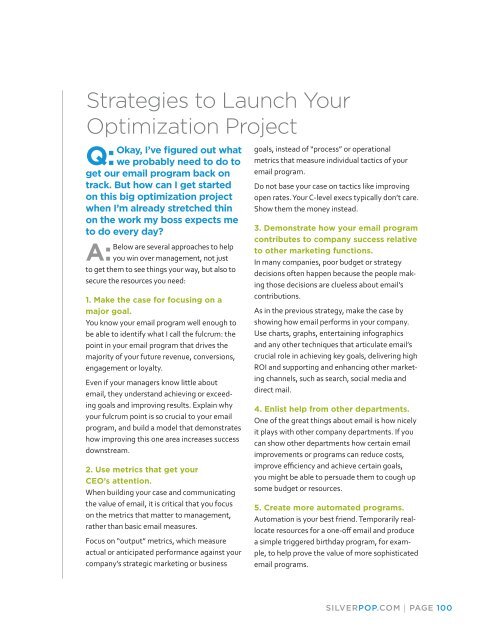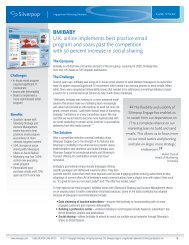eBook - Silverpop
eBook - Silverpop
eBook - Silverpop
Create successful ePaper yourself
Turn your PDF publications into a flip-book with our unique Google optimized e-Paper software.
Strategies to Launch Your<br />
Optimization Project<br />
Okay, I’ve figured out what<br />
Q: we probably need to do to<br />
get our email program back on<br />
track. But how can I get started<br />
on this big optimization project<br />
when I’m already stretched thin<br />
on the work my boss expects me<br />
to do every day?<br />
Below are several approaches to help<br />
A: you win over management, not just<br />
to get them to see things your way, but also to<br />
secure the resources you need:<br />
1. Make the case for focusing on a<br />
major goal.<br />
You know your email program well enough to<br />
be able to identify what I call the fulcrum: the<br />
point in your email program that drives the<br />
majority of your future revenue, conversions,<br />
engagement or loyalty.<br />
Even if your managers know little about<br />
email, they understand achieving or exceeding<br />
goals and improving results. Explain why<br />
your fulcrum point is so crucial to your email<br />
program, and build a model that demonstrates<br />
how improving this one area increases success<br />
downstream.<br />
2. Use metrics that get your<br />
CEO’s attention.<br />
When building your case and communicating<br />
the value of email, it is critical that you focus<br />
on the metrics that matter to management,<br />
rather than basic email measures.<br />
Focus on “output” metrics, which measure<br />
actual or anticipated performance against your<br />
company’s strategic marketing or business<br />
goals, instead of “process” or operational<br />
metrics that measure individual tactics of your<br />
email program.<br />
Do not base your case on tactics like improving<br />
open rates. Your C-level execs typically don’t care.<br />
Show them the money instead.<br />
3. Demonstrate how your email program<br />
contributes to company success relative<br />
to other marketing functions.<br />
In many companies, poor budget or strategy<br />
decisions often happen because the people making<br />
those decisions are clueless about email’s<br />
contributions.<br />
As in the previous strategy, make the case by<br />
showing how email performs in your company.<br />
Use charts, graphs, entertaining infographics<br />
and any other techniques that articulate email’s<br />
crucial role in achieving key goals, delivering high<br />
ROI and supporting and enhancing other marketing<br />
channels, such as search, social media and<br />
direct mail.<br />
4. Enlist help from other departments.<br />
One of the great things about email is how nicely<br />
it plays with other company departments. If you<br />
can show other departments how certain email<br />
improvements or programs can reduce costs,<br />
improve efficiency and achieve certain goals,<br />
you might be able to persuade them to cough up<br />
some budget or resources.<br />
5. Create more automated programs.<br />
Automation is your best friend. Temporarily reallocate<br />
resources for a one-off email and produce<br />
a simple triggered birthday program, for example,<br />
to help prove the value of more sophisticated<br />
email programs.<br />
SILVERPOP.COM | PAGE 100







